Codes
Use the Codes option to estimate a block model according to separate regions by matching blocks with their corresponding samples. In addition, it can also estimate multiple variables during the same estimation run.
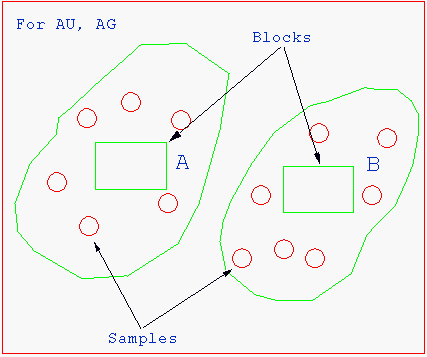
Block Estimation
This option is used to specify that blocks with code A are only estimated using samples with a code A, and also that B blocks are estimated only with B samples. This matching is defined by supplying a list of code pairs where each pair associates a set of blocks with their corresponding samples. In the above example, the code pairs are A, A and B, B.
Prior to using this option, you must set up a set of estimation parameters to act as the template for estimating all the regions and variables. These parameters are created using the standard options for specifying estimation parameters (that is, the Inverse, Ordinary, Indicator, Stochastic and New Estimation File options).
Note: The template must contain a dummy estimation and composite variable, but it must not have any block/sample restrictions specified. The estimation variable and block/sample selection components of the parameters are overwritten with the values specified in this option.
Instructions
On the Block menu, point to Grade Estimation, and then click Codes to display the Estimation Parameter file panel.

Estimation parameter file
Enter, or select from the drop-down list, the name ( <name> ) part of the parameter file. The full name is <proj><name>.bef.
Click OK.
The Template ID panel is then displayed.
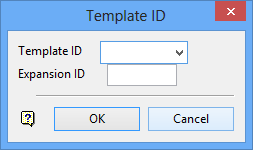
Use this panel to specify which estimation ID to use as the estimation template.
Template ID
Enter, or select from the drop-down list, the estimation ID to use as the template. The drop-down list contains all the Ids that are stored in the estimation file (.bef) that was specified on the previous panel.
Expansion ID
Enter the identifier to be used to record the Codes parameters. These parameters, set up in the next panels, are recorded in the estimation.bef file for later use. By specifying a previous expansion ID, you can edit a set of existing Codes specifications.
Click OK to display the Estimation Variables panel.
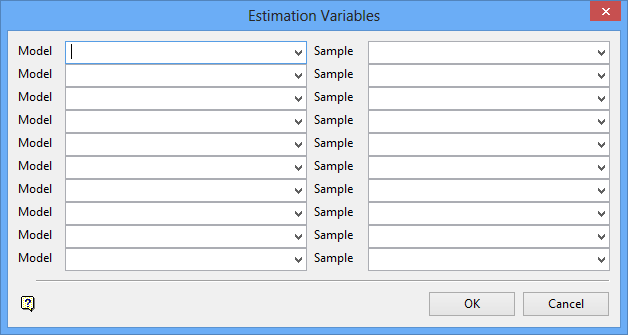
Use this panel to specify the list of variables to estimate. You will then need to set the list of code pairs. Each pair consists of a block model value and an associated composite sample value.
You will need to specify the block model variable containing the block values, as well as the composite database field containing the sample values.
Model
Select the name of the variable in the block model to store the results of an estimation.
Sample
Select the field in the composite database containing the values used to estimate the block model variable specified in the model section of the panel. The list of fields is obtained from the compositing database specified in the estimation template parameters. Up to 10 variables can be specified in a single run estimation.
Click OK.
The Matching Code Pairs dialog box is then displayed.
Add code pair
Select this option to add a code pair.
Modify code pair
Select this option to modify an existing code pair.
Delete code pair
Select this option to delete an existing code pair.
Set code variables
Select this option to set the names of the block model variable containing the block values and the field in the composite database containing the sample values.
Add code pair
The following panel displays.
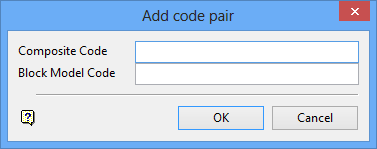
Composite Code
Enter the composite value. Only composites with this value are selected by this code pair.
Block Model Code
Enter the block value. Only blocks with this value are selected by this code pair.
Click OK.
You must then set the code variables before the estimation run can be performed. These variables are set through the Code Variables panel.
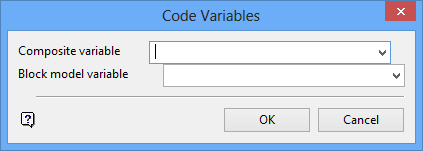
Composite variable
Enter, or select from the drop-down list, the name of the field in the composite database that contains the code pair values. The list of fields is taken from the composite database defined in the estimation template parameters.
Block model variable
Enter, or select from the drop-down list, the name of the variable in the block model that contains the code pair values. The list of variables is obtained from the open block model.
Click OK.
Cancel when you have finished setting the codes parameters. They are saved in the specified estimation.bef file using the expansion identifier.
Before any estimation is performed, you must confirm the estimation run. Estimate Grades performs an estimation run on the open block model using the specified Codes parameters. The grade estimation is run in a shell window. Don't estimate exits the option without any estimation being performed.
Modify code pair
A list of code pairs displays. Select the required pair from this list, then use the Modify code pair panel to make any modifications.

Composite Code
Enter the composite value.
Block Model Code
Enter the block value.
Click OK.
Delete code pair
A list of code pairs displays. Select the required pair from this list. The selected pair are highlighted and when you exit the option, you are prompted to confirm the deletion of the highlighted pair.

